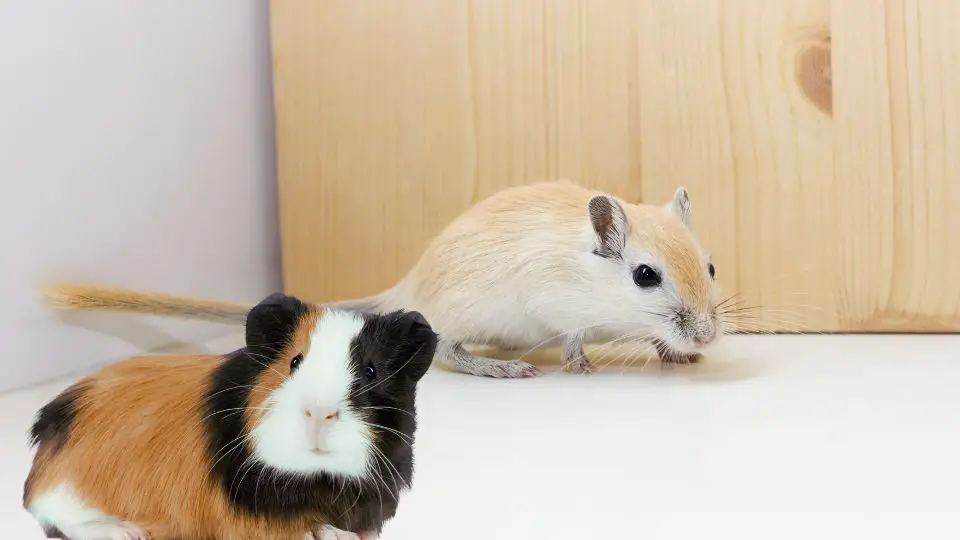As a pet owner, you may wonder if it’s suitable to house a gerbil in a hamster cage.
Yes, you can put a gerbil in a hamster cage. However, note that hamster cages may not provide the optimal space, ventilation, and security that gerbils require. It’s recommended to invest in a gerbil-specific habitat to ensure the well-being and happiness of your gerbil.
In this article, we will explore the considerations and potential challenges associated with using a hamster cage for gerbils.
Considerations for Housing Gerbils
When it comes to housing gerbils, it’s essential to consider their specific needs and behaviors. Gerbils are active and curious rodents that require a suitable and spacious habitat to thrive.
Here is what we recommend to keep in mind when providing housing for gerbils:
- Space: Gerbils are highly active animals and require ample space to explore, run, burrow, and play. It is recommended to provide a habitat that is at least 10 gallons in size per gerbil, with more space being even better. This allows them to exhibit their natural behaviors and prevents feelings of confinement.
- Burrowing: Gerbils are natural burrowers, so it’s important to provide them with bedding and substrate that allows for digging and tunneling. Choose bedding materials that are safe, dust-free, and suitable for burrowing, such as aspen shavings or paper-based bedding.
- Multi-level and Enrichment: Gerbils also enjoy climbing and exploring different levels in their habitat. Consider providing multi-level enclosures or adding platforms, ramps, and tunnels to create a stimulating environment. This allows them to exercise, promote their natural instincts, and prevent boredom.
- Ventilation: Proper airflow is crucial for maintaining a healthy environment for gerbils. Ensure that the habitat has adequate ventilation to prevent the buildup of ammonia and odors. Avoid using enclosures with poor ventilation, such as aquariums with limited airflow.
- Safety: Gerbils are skilled chewers, so you should choose a cage made of sturdy materials that they cannot chew through. Avoid cages with plastic components, as gerbils may chew and ingest them, leading to potential health issues.
Evaluating Hamster Cages for Gerbils
While it is possible to house a gerbil in a hamster cage, it is generally not recommended. Gerbils have different housing requirements compared to hamsters, and a hamster cage may not provide the ideal environment for a gerbil’s well-being. Gerbils are active and curious animals that require ample space to explore, burrow, and exercise.
Hamster cages may not always offer enough room or suitable features to meet their needs. Additionally, the bar spacing in a typical hamster cage may be too wide for a gerbil, allowing them to escape or potentially get stuck. It’s best to choose a gerbil-specific cage or habitat that is designed to accommodate their natural behaviors and provide them with a safe and stimulating environment.
Here is what we consider the key factors when evaluating hamster cages for gerbils:
- Size and Design: Gerbils are active animals that require plenty of space to move around and engage in their natural behaviors. Evaluate the size of the hamster cage and ensure it provides enough room for gerbils to explore, run, dig, and burrow. Look for cages that offer a sufficient floor space and vertical space to accommodate multiple levels and accessories.
- Bar Spacing: Gerbils have slender bodies that can squeeze through small spaces. Check the bar spacing of the hamster cage to ensure it is appropriate for gerbils. The gaps between the bars should be narrow enough to prevent them from escaping. A general guideline is to look for bar spacing that is less than 1/2 inch (1.27 cm).
- Escape Routes: Gerbils are skilled climbers and jumpers. Assess the cage’s design and look for potential escape routes, such as large gaps or openings that could allow the gerbils to escape. Ensure that all access points, including doors and lids, are secure and cannot be easily opened by the gerbils.
- Ventilation and Cleaning: Proper airflow and ventilation are important for maintaining a healthy living environment for gerbils. Evaluate the cage’s ventilation system and ensure it provides adequate airflow to prevent the buildup of ammonia and odors. Additionally, consider how easy it is to clean the cage and remove any soiled bedding or waste.
Potential Challenges and Risks
One potential challenge is ventilation and airflow within the cage. Gerbils require proper air circulation to maintain good respiratory health. Hamster cages may not always offer adequate ventilation, as they are designed with the needs of hamsters in mind. Insufficient airflow can lead to the buildup of ammonia from urine and feces, which can be harmful to gerbils. It’s crucial to ensure that the cage you choose for your gerbils provides proper ventilation and allows for the exchange of fresh air.
Another consideration is the potential for territorial conflicts between gerbils. Gerbils are social animals that thrive in groups or pairs, but they also have a strong territorial instinct. Placing multiple gerbils in a hamster cage can lead to territorial disputes, which can result in aggression, stress, and even injuries. Gerbils require enough space to establish their territories and have separate areas for nesting, feeding, and exercising. A hamster cage may not provide enough room to accommodate these needs, increasing the likelihood of conflicts.
To mitigate these challenges, it is recommended to provide a gerbil-specific cage or habitat that meets their specific requirements. Gerbil cages are designed with appropriate bar spacing to prevent escapes and offer features such as tunnels, platforms, and hiding spots for them to explore and engage in their natural behaviors. These cages also allow for better ventilation and airflow, promoting a healthier environment for your gerbils.
Alternatives and Recommended Gerbil Housing
While hamster cages may not be the ideal choice for gerbils, there are alternative options that are better suited for their well-being. Let’s explore other alternatives that we recommend as housing options for gerbils.
- Gerbil Cages: Gerbil-specific cages are designed with the needs of gerbils in mind. These cages usually have narrow bar spacing to prevent escape and provide ample space for gerbils to move, explore, and burrow. They often feature multiple levels, tunnels, platforms, and hiding spots, offering a stimulating and enriching environment for gerbils.
- Glass Tanks: Glass tanks or aquariums can also serve as suitable habitats for gerbils. They provide a spacious and secure enclosure, and the transparent walls allow for easy observation of your gerbils’ activities. When using a glass tank, make sure to provide a secure mesh or wire lid for ventilation and to prevent escapes.
- DIY Bin Cages: Another option is to create a DIY bin cage using a large plastic storage bin. These cages can be customized to provide ample space and enrichment for gerbils. Make sure to choose a bin that is large enough and has proper ventilation by adding small holes or wire mesh.
The benefits of providing a gerbil-specific habitat include:
- Ample Space: Gerbils are active animals that require sufficient space to exercise, play, and burrow. Gerbil cages or tank setups offer the necessary room for them to engage in their natural behaviors.
- Enrichment Opportunities: Gerbil habitats often come with features such as tunnels, platforms, and nesting areas, providing ample opportunities for exploration and enrichment. Adding toys, tunnels, and chewable items can further enhance their environment.
- Better Ventilation: Gerbil-specific cages and tank setups are designed to offer proper ventilation, ensuring a fresh and healthy living space for your gerbils.
- Easy Maintenance: Many gerbil cages are designed with convenient features for cleaning, such as removable trays and access doors, making maintenance easier for you.
What cage is best for gerbils?
When it comes to choosing the best cage for gerbils, there are a few factors to consider. Gerbils have specific needs and behaviors that should be taken into account to ensure their well-being. While wooden cages may have aesthetic appeal, they may not be the most suitable option for gerbils.
Here are some factors you should consider that will help you make an informed decision:
- Bar Spacing: Gerbils are small rodents with the ability to squeeze through small spaces. It’s important to choose a cage with narrow bar spacing (around 1/4 inch or 6mm) to prevent them from escaping. Wooden cages may have larger gaps between the bars, making them less suitable for gerbils.
- Ventilation: Gerbils require good airflow within their habitat to maintain a healthy environment. Wooden cages may not provide sufficient ventilation compared to cages made of wire or mesh, which allow for proper air circulation.
- Chewing Behavior: Gerbils are avid chewers, and wooden cages may be susceptible to damage from their constant gnawing. This can lead to potential escape routes or structural issues over time. Metal or plastic cages are generally more durable and better suited to withstand their chewing habits.
- Cleaning and Hygiene: Gerbil cages should be easy to clean and maintain. Wooden cages may absorb odors and moisture, making it harder to keep them clean and hygienic. Cages made of non-porous materials like metal or plastic are typically easier to clean and sanitize.
Can a gerbil live in a wooden cage?
While gerbils can technically live in a wooden cage, it’s generally not the recommended housing option for several reasons. Wooden cages may have larger gaps between the bars, allowing gerbils to escape. Gerbils are skilled chewers, and wooden cages are more susceptible to damage from their constant gnawing. Additionally, wooden cages may absorb odors and moisture, making them harder to clean and maintain.
Conclusion
While it may be tempting to use a hamster cage for gerbils, it’s important to consider their unique needs and behaviors. Hamster cages may not provide the optimal space, ventilation, and security that gerbils require. It’s recommended to invest in a gerbil-specific habitat, such as a wire or mesh cage or a glass tank with a secure lid.
These alternatives offer suitable bar spacing, good ventilation, and the ability to accommodate the natural behaviors of gerbils. By providing an appropriate living environment, you can ensure the health, well-being, and happiness of your gerbil companion.







